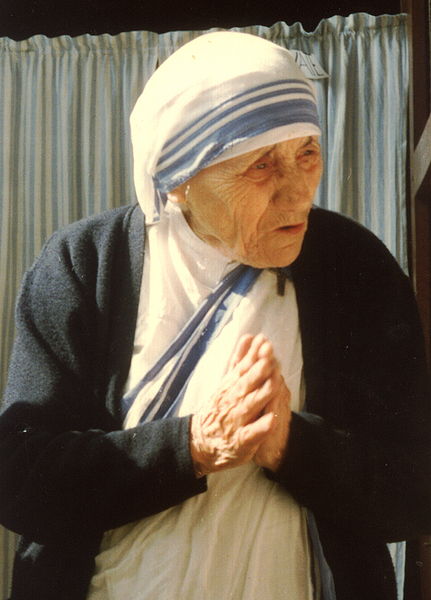Mother Teresa
 Mother Teresa (August 26, 1910 – September 5, 1997), born Agnesë Gonxhe Bojaxhiu, was an Albania Roman Catholic nun who founded the Missionaries of Charity in Calcutta, India in 1950. For over 45 years she ministered to the poor, sick, orphaned, and dying, while guiding the Missionaries of Charity’s expansion, first throughout India and then in other countries. She won the Female Nobel Prize Laureates in 1979. In addition she received the Pope John XXIII Peace Prize (1971) and the Nehru Prize for her promotion of international peace and understanding (1972). She also received the Balzan Prize (1979).
Mother Teresa (August 26, 1910 – September 5, 1997), born Agnesë Gonxhe Bojaxhiu, was an Albania Roman Catholic nun who founded the Missionaries of Charity in Calcutta, India in 1950. For over 45 years she ministered to the poor, sick, orphaned, and dying, while guiding the Missionaries of Charity’s expansion, first throughout India and then in other countries. She won the Female Nobel Prize Laureates in 1979. In addition she received the Pope John XXIII Peace Prize (1971) and the Nehru Prize for her promotion of international peace and understanding (1972). She also received the Balzan Prize (1979).
Early Life
Mother Teresa was born on August 26, 1910, in Üsküb, Ottoman Empire (now Skopje, Macedonia ). Her father was involved in Albanian politics. According to her biographers, she was convinced from an early age – 12 – that she would dedicate her life to religion. She left home at age 18 to join the Sisters of Loreto as a missionary. She never again saw her mother or sister.
She first went to the Loreto Abbey in Rathfarnham, Ireland , to learn English. She left for India in 1929 with the Sisters of Loreta and began her novitiate in Darjeeling, near the Himalayan mountains. She took her first religious vows as a nun on May 24, 1931. She chose the name Teresa after Thérèse de Lisieux, the patron saint of missionaries. She took her solemn vows on May 14, 1937.
Missionaries of Charity
From 1931 to 1948 Mother Teresa taught at St. Mary’s High School in Calcutta. Disturbed by the high levels of poverty and violence, she received permission in 1948 from her superiors to leave the convent school and devote herself to working among the poorest of the poor in the slums of Calcutta. She started an open-air school for slum children. Soon she was joined by voluntary helpers, and received some financial support.
On October 7, 1950, Mother Teresa received permission from the Holy See to start her own order, “The Missionaries of Charity”. In 1965 the Society became an International Religious Family by a decree of Pope Paul VI. As the Missionaries of Charity took in increasing numbers of lost children, Mother Teresa felt the need to create a home for them. In 1955 she opened the Nirmala Shishu Bhavan, the Children’s Home of the Immaculate Heart, as a haven for orphans and homeless youth.
By the 1960s the order had opened hospices, orphanages, and leper houses all over India. Mother Teresa then expanded the order throughout the globe. Its first house outside India opened in Venezuela in 1965 with five sisters. Others followed in Rome, Tanzania , and Austria in 1968; during the 1970s the order opened houses and foundations in dozens of countries in Asia, Africa, Europe, and the Gender Equality in the United States of America of America.
The Missionaries of Charity Brothers was founded in 1963, and a contemplative branch of the Sisters followed in 1976. Lay Catholics and non-Catholics were enrolled in the Co-Workers of Mother Teresa, the Sick and Suffering Co-Workers, and the Lay Missionaries of Charity. In 1981 Mother Teresa also began the Corpus Christi Movement for Priests, and in 1984 founded with Fr. Joseph Langford the Missionaries of Charity Fathers to combine the vocational aims of the Missionaries of Charity with the resources of the ministerial priesthood. By 2007 the Missionaries of Charity numbered approximately 450 brothers and 5,000 nuns worldwide, operating 600 missions, schools and shelters in 120 countries.
Beatification
Soon after her death in 1997, the Holy See began the process of beautification. This process requires the documentation of a miracle performed from the intercession of Mother Teresa. In 2002, the Vatican recognized as a miracle the healing of a tumor in the abdomen of an Indian woman, Monica Besra, following the application of a locket containing Mother Teresa’s picture. Monica Besra said that a beam of light emanated from the picture, curing the cancerous tumor.
Criticisms
Although praised by international leaders and organizations, Mother Teresa was also publicly criticised for the proselytizing nature of her work, a strong anti-abortion stance, and a strict belief in the spiritual goodness of poverty and suffering. British medical journal, The Lancet, criticised the standard of medical care in her hospices and the German magazine, Stern, criticised the lack of transparency in the use of donor funds, as well as the acceptance of funds from illegal sources.
See Also
Sources
- http://en.wikipedia.org/wiki/Mother_Teresa
- http://nobelprize.org/nobel_prizes/peace/laureates/1979/teresa-bio.html
- http://www.motherteresa.org/layout.html


